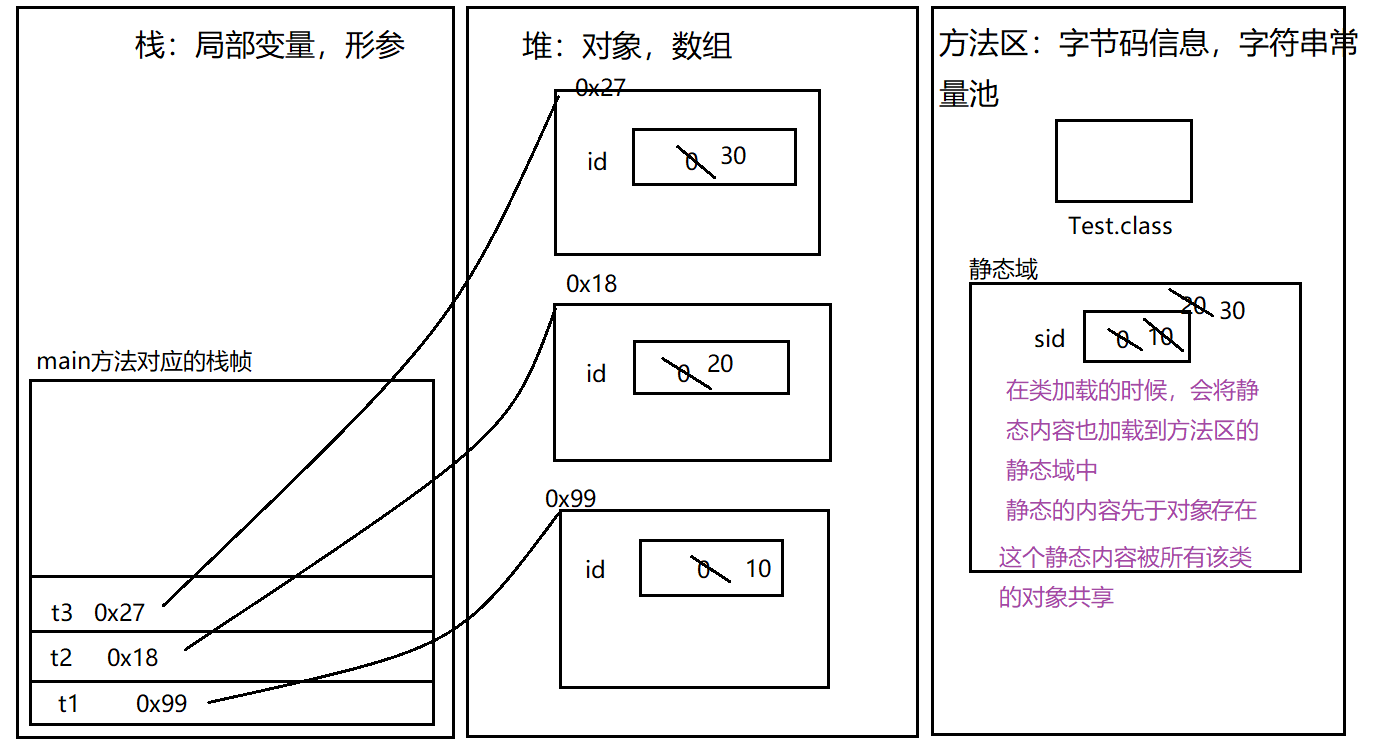## 1.static和public都是修飾符,并列的沒有先后順序,先寫誰后寫誰都行
## 2.在靜態方法中不能使用this關鍵字
## 3.在靜態方法中不能訪問非靜態的方法
## 4.在靜態方法中不能訪問非靜態的屬性
## 5.非靜態的方法可以用對象名.方法名去調用
## 6.靜態的方法可以用? 對象名.方法名去調用? 也可以 用? 類名.方法名 (推薦)
1】static可以修飾:屬性,方法,代碼塊,內部類。
【2】static修飾屬性;
~~~
package com.msb5;
/**
* @Auther: msb-zhaoss
*/
public class Test {
//屬性:
int id;
static int sid;
//這是一個main方法,是程序的入口:
public static void main(String[] args) {
//創建一個Test類的具體的對象
Test t1 = new Test();
t1.id = 10;
t1.sid = 10;
Test t2 = new Test();
t2.id = 20;
t2.sid = 20;
Test t3 = new Test();
t3.id = 30;
t3.sid = 30;
//讀取屬性的值:
System.out.println(t1.id);
System.out.println(t2.id);
System.out.println(t3.id);
System.out.println(t1.sid);
System.out.println(t2.sid);
System.out.println(t3.sid);
}
}
~~~
## 內存分析:

## 一般官方的推薦訪問方式:可以通過類名.屬性名的方式去訪問:
## static修飾屬性總結:
##
## (1)在類加載的時候一起加載入方法區中的靜態域中
##
## (2)先于對象存在
##
## (3)訪問方式: 對象名.屬性名 ? ?類名.屬性名(推薦)
static修飾屬性的應用場景:某些特定的數據想要在內存中共享,只有一塊 --》這個情況下,就可以用static修飾的屬性
```
* package com.msb5;
* /\*\*
* \* @Auther: msb-zhaoss
* \*/
* public class Demo {
* ? ? int id;
* ? ? static int sid;
* ? ? public void a(){
* ? ? ? ? System.out.println(id);
* ? ? ? ? System.out.println(sid);
* ? ? ? ? System.out.println("------a");
* ? ? }
* ? ? //1.static和public都是修飾符,并列的沒有先后順序,先寫誰后寫誰都行
* ? ? static public void b(){
* ? ? ? ? //System.out.println(this.id);//4.在靜態方法中不能使用this關鍵字
* ? ? ? ? //a();//3.在靜態方法中不能訪問非靜態的方法
* ? ? ? ? //System.out.println(id);//2.在靜態方法中不能訪問非靜態的屬性
* ? ? ? ? System.out.println(sid);
* ? ? ? ? System.out.println("------b");
* ? ? }
* ? ? //這是一個main方法,是程序的入口:
* ? ? public static void main(String\[\] args) {
* ? ? ? ? //5.非靜態的方法可以用對象名.方法名去調用
* ? ? ? ? Demo d = new Demo();
* ? ? ? ? d.a();
* ? ? ? ? //6.靜態的方法可以用? 對象名.方法名去調用? 也可以 用? 類名.方法名 (推薦)
* ? ? ? ? Demo.b();
* ? ? ? ? d.b();
* ? ? ? 
* ? ? }
* }
```
屬性:
靜態屬性 (類變量)
非靜態屬性(實例變量)
【3】static修飾方法;
